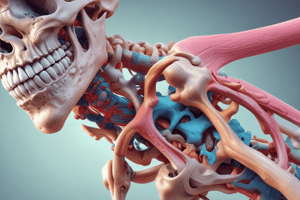Podcast
Questions and Answers
Which of these conditions is NOT typically associated with secondary osteoporosis?
Which of these conditions is NOT typically associated with secondary osteoporosis?
- Hypothyroidism (correct)
- Hyperparathyroidism
- Growth hormone deficiency
- Hyperthyroidism
What is the characteristic feature of age-related osteoporosis that differentiates it from post-menopausal osteoporosis?
What is the characteristic feature of age-related osteoporosis that differentiates it from post-menopausal osteoporosis?
- Increased turnover at the bone vascular interface within cortical bone (correct)
- Decreased turnover at the bone vascular interface within cancellous bone
- Increased bone breakdown by osteoclasts in the cortical bone
- Increased bone formation by osteoblasts in the cancellous bone
What is a common presenting symptom of osteoporosis?
What is a common presenting symptom of osteoporosis?
- Chronic muscle fatigue
- Persistent joint stiffness
- Sudden onset of back pain (correct)
- Progressive loss of appetite
Which of the following medications is NOT commonly associated with an increased risk of osteoporosis?
Which of the following medications is NOT commonly associated with an increased risk of osteoporosis?
Which of the following is NOT a risk factor for osteoporosis that contributes to the calculation of the FRAX score?
Which of the following is NOT a risk factor for osteoporosis that contributes to the calculation of the FRAX score?
What is the most common type of fracture associated with osteoporosis?
What is the most common type of fracture associated with osteoporosis?
What is the primary mechanism by which osteoporosis develops?
What is the primary mechanism by which osteoporosis develops?
Which of the following genes is NOT known to be associated with an increased risk of osteoporosis?
Which of the following genes is NOT known to be associated with an increased risk of osteoporosis?
Flashcards
Osteoporosis
Osteoporosis
A progressive bone disease with reduced bone density and increased fracture risk.
Causes of Osteoporosis
Causes of Osteoporosis
Increased bone breakdown by osteoclasts and decreased formation by osteoblasts.
Primary Osteoporosis
Primary Osteoporosis
Osteoporosis not due to another medical condition, includes post-menopausal and age-related types.
Post-menopausal Osteoporosis
Post-menopausal Osteoporosis
Signup and view all the flashcards
Secondary Osteoporosis
Secondary Osteoporosis
Signup and view all the flashcards
Risk Factors - FRAX Score
Risk Factors - FRAX Score
Signup and view all the flashcards
Common Fractures in Osteoporosis
Common Fractures in Osteoporosis
Signup and view all the flashcards
Presentation of Osteoporosis
Presentation of Osteoporosis
Signup and view all the flashcards
Study Notes
Osteoporosis Overview
- Osteoporosis is a progressive bone disease increasing fragility fracture risk.
- Characterized by reduced bone mineral density and microarchitectural defects.
- More prevalent in women, Caucasians, and Asians.
Causes of Osteoporosis
- Bone Turnover Imbalance: Increased osteoclast activity (bone breakdown) and reduced osteoblast activity (bone formation) lead to bone mass loss.
- Genetics: Genes like collagen type 1A1, vitamin D receptor, and estrogen receptor genes play a role.
Types of Osteoporosis
- Primary Osteoporosis:
- Post-Menopausal Osteoporosis: Increased remodeling units, premature osteoblast cessation, and trabecular perforation contribute to fracture susceptibility.
- Age-Related Osteoporosis: Increased bone turnover at the cortical bone vascular interface weakens long bone structure.
- Secondary Osteoporosis: Various conditions contribute:
- Endocrine Disorders: Hyperthyroidism, hyperparathyroidism, growth hormone deficiency, Cushing's syndrome.
- Metabolic Conditions: Diabetes, malabsorption (IBD, coeliac, chronic pancreatitis, gastrectomy), chronic kidney disease (CKD), chronic liver disease, COPD, sickle cell anaemia.
- Other Factors: Osteogenesis imperfecta, homocystinuria, alcohol abuse, hypogonadism (Turner's syndrome, testosterone deficiency), immobilisation.
- Medications: Prolonged glucocorticoid use (e.g., prednisolone), selective serotonin reuptake inhibitors (SSRIs), antiepileptics, proton pump inhibitors (PPIs), glitazones, long-term heparin therapy, aromatase inhibitors (e.g., anastrozole), Carbamazepine, anti-oestrogens.
Risk Factors and Assessment
- FRAX Score: Used to estimate the 10-year probability of fracture.
- Indications for FRAX: Women aged 65+ or men aged 75+, or younger individuals with certain risk factors.
- FRAX Components: age, sex, previous fracture history, parental history of hip fracture, low body mass index (BMI), smoking, glucocorticoid use, rheumatoid arthritis, secondary osteoporosis, and alcohol consumption.
Presentation of Osteoporosis
- Asymptomatic Stage: Typically asymptomatic until fractures occur.
- Fractures:
- Vertebral Compression Fractures: Acute back pain, restricted spinal movement, intensified pain with weight bearing, thoracic kyphosis (dowager's hump).
- Appendicular Fractures (e.g., hip, distal radius): Pain, inability to bear weight, shortened/externally rotated leg (hip), wrist pain, reduced movement, dinner-fork deformity (Colles fracture).
- Other Fractures: Humerus, pelvis.
Studying That Suits You
Use AI to generate personalized quizzes and flashcards to suit your learning preferences.



